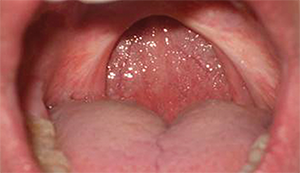Options abound for addressing the hypopharynx in patients who have obstructive sleep apnea (OSA); however, choosing an approach is not always straightforward.
Panelists involved in a session focused on hypopharyngeal collapse reviewed some of the ins and outs of traditional surgery, upper airway stimulation, and transoral robotic surgery (TORS).
Traditional Surgical Procedures
Jimmy Brown, DDS, MD, professor of otolaryngology-head and neck surgery at Augusta University in Georgia, said the abundance of surgical options—genioglossus advancement, hyoid suspension, and hyoid myotomy among them—does not necessarily translate to optimal results. “The surgical options are numerous, and usually that’s the case when none of them works really well,” he said.

Patient following a uvulopalatopharyngoplasty.
© wikipedia
Genial tubercle advancement (GTA) is still considered the “standard” for dealing with hypopharyngeal collapse but is sometimes thought to be associated with a high complication rate, Dr. Brown said. The numbers actually don’t bear that out, with studies showing a 0.3% to 2% complication rate, he said. “If you look at the early series, the complication rates were pretty small and probably should not deter us as otolaryngologists to incorporate that procedure into our armamentarium,” he added.
Comparing Outcomes
When outcomes for hypopharyngeal procedures are compared, though, there is no clear winner. The majority of studies are level 4 (evidence-based medicine) and are case series. Looking at a systematic review of eight studies comprising 151 patients, GTA in combination with uvulopalatopharyngoplasty (UPPP) had a success rate of 61%. For hyoid suspension with UPPP, a review of five studies comprising 123 patients had a success rate of 71%. For tongue suspension with UPPP, a review of eight studies (167 patients) had a success rate of 62%.
“They all pretty much have the same outcomes,” Dr. Brown said, acknowledging that these were not high-powered studies.
Additional research has found that better outcomes are more common for stand-alone hyoid procedures when compared with stand-alone base-of-tongue procedures, with rates of 56% and 36% respectively (Laryngoscope. 2014;124:329–336; Otolaryngol Head Neck Surg. 2011;144:225–229).
“If you have to do one thing or the other, maybe securing the hyoid would be more efficacious,” said Dr. Brown. “Stabilizing the hyoid impacts all the collapsible walls of the hypopharynx, while stabilizing the tongue only primarily impacts the anterior wall of the hypopharynx.”
Upper Airway Stimulation
M. Boyd Gillespie, MD, MSc, chair of otolaryngology at the University of Tennessee in Memphis and a member of the ENTtoday editorial advisory board, gave an update on upper airway stimulation, an approach that is becoming more popular for treating patients intolerant to continuous positive airway pressure (CPAP).
At three years, 98 patients from the pivotal Stimulation Therapy for Apnea Reduction (STAR) trial on the Inspire device underwent an optional repeat sleep study (N Engl J Med. 2014;370:139–149). The overall apnea-hypopnea index (AHI) was 6.2 in these patients. “It shows that this device is still quite effective on average in this group of patients,” Dr. Gillespie said. At 48 months, 85% of patients were still reporting soft snoring or no snoring, he said.
A competing device from ImThera Medical is now in a phase 3 trial, Dr. Gillespie said. “It’s a much simpler design, it’s an easier surgery, [and] it takes about 45 minutes to do,” he said. “It’s a small device. So it will be interesting to see the outcomes of that.”
He noted that evaluation of patients with drug-induced sleep endoscopy (DISE) was a requirement in the Inspire trial but is not required for the ImThera device. Whether or not DISE should be used in evaluation patients before upper airway stimulation, he said, is “a question that needs to be answered.”
TORS
Erica Thaler, MD, professor of otorhinolaryngology-head and neck surgery at the University of Pennsylvania in Philadelphia, said that while she’s been using more upper airway stimulation lately, TORS remains “an important thing to consider and an important part of surgical management.”
In her cases, TORS patients who have not undergone prior surgery have experienced a 67% reduction in AHI, which is approximately double the rate seen in patients treated with UPPP alone (Laryngoscope. 2016;126:266–269).
Dr. Thaler suggested waiting long enough during an evaluation to notice what is happening with the epiglottis. Approximately 10% to 15% of the time, there will be collapse. Anterior-posterior collapse, as opposed to lateral to medial collapse, is harder to address and should be dealt with during the surgery, she said.
“One of the things that I’ve learned, as I’ve done it more with DISE, is that I’ve paid more attention to the epiglottis.”
Thomas Collins is a freelance medical writer based in Florida.
Take-Home Points
- GTA for hypopharyngeal collapse shouldn’t be avoided out of concern over complication rate; the rate is low.
- Three-year data show persistent success for upper airway stimulation.
- Assessment of the epiglottis during DISE is worthwhile before TORS procedures.